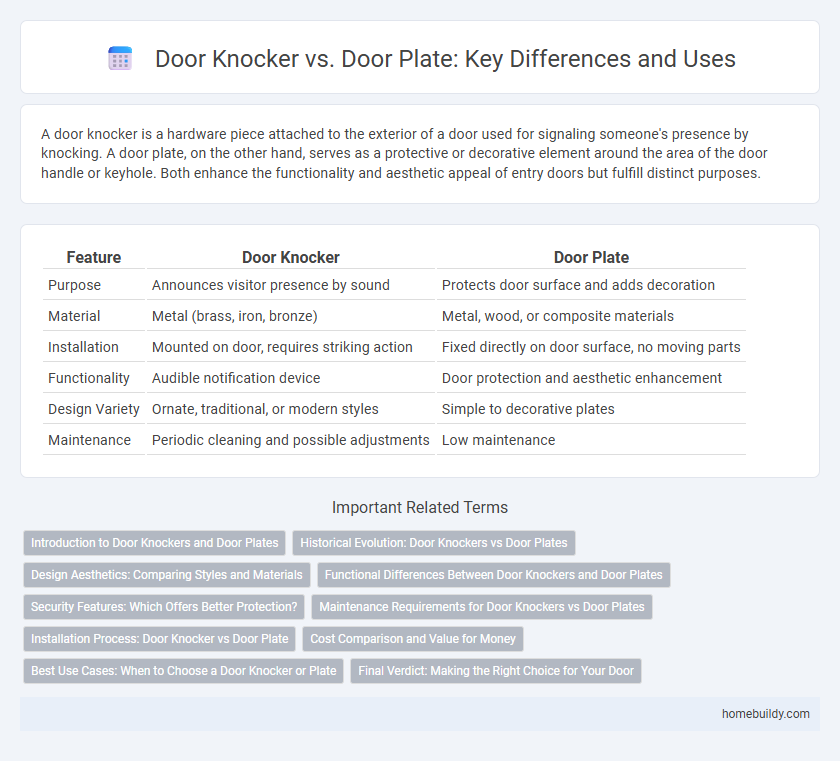A door knocker is a hardware piece attached to the exterior of a door used for signaling someone's presence by knocking. A door plate, on the other hand, serves as a protective or decorative element around the area of the door handle or keyhole. Both enhance the functionality and aesthetic appeal of entry doors but fulfill distinct purposes.
Table of Comparison
| Feature | Door Knocker | Door Plate |
|---|---|---|
| Purpose | Announces visitor presence by sound | Protects door surface and adds decoration |
| Material | Metal (brass, iron, bronze) | Metal, wood, or composite materials |
| Installation | Mounted on door, requires striking action | Fixed directly on door surface, no moving parts |
| Functionality | Audible notification device | Door protection and aesthetic enhancement |
| Design Variety | Ornate, traditional, or modern styles | Simple to decorative plates |
| Maintenance | Periodic cleaning and possible adjustments | Low maintenance |
Introduction to Door Knockers and Door Plates
Door knockers serve as decorative and functional hardware that allow visitors to announce their presence by producing a sound when struck against the door. Door plates, also known as backplates or escutcheons, primarily provide a protective and ornamental surface around the door handle or knob, often featuring intricate designs to enhance aesthetics. While door knockers emphasize traditional engagement and tactile interaction, door plates focus more on protection against wear and decorative complement to the door's overall design.
Historical Evolution: Door Knockers vs Door Plates
Door knockers have a rich historical evolution, serving both functional and decorative purposes since ancient times, prominently made from metals like brass and iron to symbolize status and craftsmanship. Door plates emerged later, focusing more on protecting the door surface and often integrating name tags or house numbers, reflecting advancements in household identification and durability needs. The shift from ornate door knockers to practical door plates illustrates changing architectural styles and social customs in home entrance design.
Design Aesthetics: Comparing Styles and Materials
Door knockers offer a classic, three-dimensional design that serves as both a functional and decorative element, often crafted from metals like brass, bronze, or wrought iron, providing a timeless appeal. Door plates, on the other hand, present a flat, smooth surface that can incorporate intricate engravings or embossing on materials such as stainless steel, aluminum, or wood veneer, resulting in a modern, sleek look. The choice between door knocker and door plate largely depends on the desired architectural style, with knockers enhancing traditional or rustic aesthetics while plates complement contemporary or minimalist designs.
Functional Differences Between Door Knockers and Door Plates
Door knockers serve as a traditional signaling device, allowing visitors to announce their presence through a loud, physical sound created by striking the door. Door plates primarily function as protective or decorative elements, safeguarding the door's surface from damage while often showcasing house numbers or names for identification. Unlike door plates, door knockers offer an interactive feature, combining utility with aesthetic appeal to enhance entryway communication.
Security Features: Which Offers Better Protection?
A door knocker primarily serves a decorative and functional role, allowing visitors to announce their presence, but it offers minimal security enhancements. In contrast, a door plate can integrate advanced security features such as reinforced locks, tamper-proof materials, and concealed keyholes that improve protection against forced entry. Homeowners seeking enhanced security benefits often find door plates more effective due to their robust construction and ability to incorporate locking mechanisms.
Maintenance Requirements for Door Knockers vs Door Plates
Door knockers typically require more frequent maintenance than door plates due to their moving parts, which need regular lubrication to prevent rust and ensure smooth operation. Door plates, being fixed and simpler in design, often only need occasional cleaning to maintain their appearance and protect against corrosion. The choice between a door knocker and a door plate impacts long-term upkeep, with door knockers demanding more attention to preserve functionality and aesthetic appeal.
Installation Process: Door Knocker vs Door Plate
The installation process of a door knocker typically involves mounting it with screws through pre-drilled holes, ensuring it is aligned at a comfortable height for use. In contrast, a door plate requires precise measurements for screw placement to properly secure around the door handle or lock, often demanding more detailed alignment for both function and aesthetics. Both installations benefit from using a drill, screwdriver, and level, but door knockers generally require fewer adjustments due to their singular purpose and design.
Cost Comparison and Value for Money
Door knockers typically cost between $20 and $150, offering a durable and decorative entryway solution with long-lasting metal materials like brass or iron. Door plates, priced around $10 to $50, provide a simpler and more affordable option for protecting door surfaces but often lack the unique aesthetic appeal of a knocker. For value-conscious buyers seeking a balance of functionality and style, door knockers deliver greater long-term value through enhanced durability and curb appeal.
Best Use Cases: When to Choose a Door Knocker or Plate
Door knockers are ideal for traditional or decorative entryways, offering a tactile and audible signal for visitors, enhancing curb appeal with intricate designs. Door plates serve best in functional settings where name identification and house numbering are essential, providing a flat surface for clear labeling and protection against wear. Choose a door knocker for aesthetic impact and ceremonial entrance signals, while a door plate is preferable for informational clarity and durability.
Final Verdict: Making the Right Choice for Your Door
Choosing between a door knocker and a door plate depends on your home's aesthetic and functionality needs. Door knockers offer a classic, ornamental touch with audible alerts for visitors, while door plates provide a subtle, protective layer that enhances durability against wear. For a blend of style and practical use, a door knocker suits traditional designs, whereas door plates are ideal for modern, minimalist entrances.
Door knocker vs Door plate Infographic

 homebuildy.com
homebuildy.com